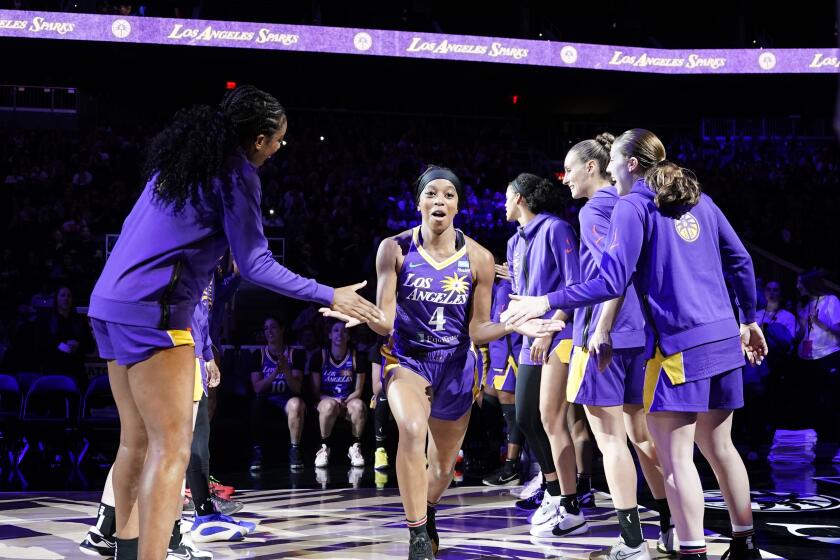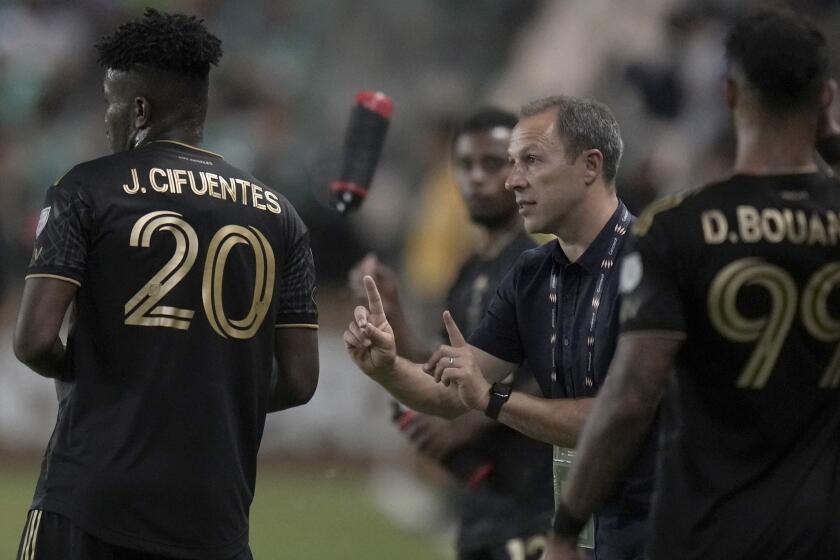The Greening of America : 2 Million New Devotees--Many of Them Women and Children--Took Up Golf Last Year
“I used to think that if I had enough time to chase after a little white ball, something was very wrong with my career,” said James E. Blancarte, a Westside attorney. “And the idea of wearing Purina checkerboard-square pants was totally unacceptable to me.”
But when a close friend bought a house at a country club, the temptation to join him on the course was too great. Blancarte took a series of 10 lessons, and by the fifth one, he was hooked with this new slice of life. He bought three beginner clubs and invested in more lessons.
Today, Blancarte, with a cadre of golf buddies, tees off two or three times a week, usually before 6 a.m. so they can get in a full nine holes before work.
Blancarte is like many of the 2 million-plus new golfers nationwide who took up the game last year. And, unlike the outdated stereotype of wealthy male retirees in their alpaca sweaters puttering leisurely around the course, many of these new golfers are dynamic, intense individuals, who are actively committed to the game.
Golf’s image is definitely changing, according to Kit Bradshaw of the National Golf Foundation, who says it’s one of the fastest growing sports in the country, with 50% of its devotees in their 20s and 30s. Women make up about 41% of the new golfers (more than 900,000 in 1988 alone), bringing their influence and buying power to the sport.
Indeed, the National Sporting Goods Assn. says equipment sales alone reached more than $960 million in 1988; clothing and shoe sales exceeded $325 million.
And with more than 23 million golfers nationwide, the golf foundation projects the numbers will be between 30 and 40 million by the turn of the century. New golfers are coming from all walks of life. In addition to women and young men, golf is becoming a big family sport, a sport for couples to play together and a sport for children. It’s not uncommon to see 7- and 8-year-old junior golfers clad in fluorescent-colored surfer shorts practicing their full swings.
Newcomers to the game take it up for a variety of reasons: to play with family and friends, to enjoy the outdoors, to add another sport to their repertoire of activities, and to relax.
“Today, everybody’s talking about stress. I believe golf is the greatest panacea known to the human race,” said Tom Barber, PGA golf professional and the Griffith Park golf course concessionaire for almost 25 years.
“When you get out on the third or fourth hole, there are no telephones, no one to bother you. You don’t have to have anyone to play with. It’s you and nature and the ball and the hole,” he said.
Barber sees the greatest increase in interest coming from women. He believes the LPGA Tour is largely responsible and credits their teaching programs with bringing more women professionals and juniors into the game.
“Golf is on a tremendous threshold of learning,” he said. “It’s becoming much better taught, with more emphasis on trusting your innate characteristics. A good teacher is someone who can make you relax and bring out more than you thought you were capable of.”
As part of the emphasis on teaching, many opportunities now exist for people to go through introductory schools, such as the one at Griffith Park, where would-be golfers learn enough of the fundamentals to get out on the course.
A series of six group lessons with a free private lesson thrown in, (with all equipment provided) will cost $60 at Griffith Park. Deborah Winters, 37, and Shelly Case, 25, are two friends who decided to take lessons, partly so they could play with their husbands, partly as a girls’ night out.
“My husband is very into golf,” said Case, whose husband has been playing for years and has a handicap of 2. “Everyone in his family plays, and I’ve always been left out. He tried to teach me, but it’s kind of like wallpapering. It’s not something you do with your spouse. He expects me to be Nancy Lopez in an hour, and I’m not.”
When Case moved to Los Angeles from Denver last year, she decided that there were so many year-round courses that it was time to learn. “I told my husband after the first class that he wasn’t to talk to me about the game for six weeks. I’m only supposed to listen to my teacher.”
Al Crawford, the golf pro who teaches Case and Winters, is an example of those changes in teaching methods. To hear his students tell it, he doesn’t expect them to be Jack Nicklaus. He makes the game simple and fun.
“He comes at it from a very simple point of view, called target golf,” Case said. “Instead of giving us all the little things that you have to do before you even get to hit the ball, he just says, ‘There’s nothing magic about it. All you’re trying to do is to get this little ball to go in that direction--and it doesn’t even have to get there in one swing.’ ”
Crawford’s approach embodies the advances in golf teaching. He gives his new students the confidence to go out and play within a relatively short time. In fact, Deborah Winters, an account executive who is learning so she can play with clients (as well as with her husband and friends), has the confidence to “talk” the game already.
“I had an opportunity to meet with a client who is known to be very closed-mouth, even dour,” Winters said. “He’s a golfer. When I mentioned I was taking golf lessons, it opened up the conversation and put it on a completely different level. It turned out to be a tremendous rapport-building tool.”
While a large number of women are taking up the sport, the number of junior golfers (children under 18 years old) is also at an all-time high. In Southern California, there are six junior golf associations that sponsor competitions, clinics and tournaments throughout the year.
Crawford heads the junior programs at Griffith Park.
“Ten years ago, Tom (Barber) and I read an article about junior golf that said golf was the last sport kids in high school would ever think of playing,” he recalled. “Fishing was ahead of golf.”
The two men decided it was time to change that situation. They got permission from the city to start a junior golf club that consisted of 10 weeks of instruction, each lesson being 1 1/2 hours. Other junior (17 years old and younger) programs throughout Southern California also offer summer instruction, usually one to two weeks.
Youngsters are divided by skill level and are taught putting, chipping and pitching. Lest they act improperly on the course, they’re taught golf etiquette--everything from how to mark their ball to how to be polite during a fellow player’s swing. The children participate in several “miniature golf tournaments,” where there are obstacles like water and sand on scaled-down versions of regular holes.
The program culminates at the end of summer with a parent-junior tournament. There is so much interest in junior golf that the LPGA offered a junior golf clinic to teach directors budgeting, organizing and ways to teach skills to squirmy, energetic tykes.
“Today, kids are playing golf at a much earlier age,” Crawford said. “When I started teaching, juniors were 14 to 18. Now, a lot of juniors are younger than 10. We have a lot of 7-year-olds.”
Earning Tokens
Craig Feustel, a 12-year-old golfer from Glendale, is so taken with the sport that he works in a pro shop vacuuming, cleaning out the storage room and picking up baskets on the golf range so he can earn tokens for range balls. Feustel won first place in the parent-junior tournament in 1988 and has been so smitten with the sport that he putts and chips with wiffle balls in his living room.
“What a shame it was that when I was in high school, golf and tennis were sissy sports,” Tom Barber says. “I don’t think you’ll find many people around today who think golf and tennis are sissy sports. Michael Jordan wants to become a professional golfer when he completes basketball; Jerry West has a one handicap; John Brodie, the former NFL quarterback, is on the senior golf tour.”
Certainly, that “sissy” image has changed. Sixteen-year-old Eric Wilhite, an avid baseball player, has been playing golf during the summer with his father, brother and grandfather. He’s had his own set of clubs for three years and caddied a lot for his father and grandfather.
“I think it’s a good sport for kids,” Wilhite says. “If you really practice, you can become good. When you go out on the course, you’re really shooting against yourself.”
Wilhite, along with his mother, Mary, who is a social worker, began to learn golf in earnest because they wanted to play with Eric’s dad and older brother.
New players aren’t the only ones thronging to the links. Golfers over 50 years old represent only 25% of golfers, but play about 50% of the rounds. And, frequent golfers have increased their play 15%, bringing the number of rounds played from 434 million in 1987 to 487 million in 1988, according to the golf foundation’s Bradshaw. All of that means one thing: golf courses are crowded.
“Right now we have such a demand for golf that we project we need to build more than one golf course a day between now and the year 2000,” Bradshaw said. In fact, just seven of the courses operated by the L.A. City Department of Recreation and Parks run more than 100,000 rounds a year. “That translates into a lot of people,” says Robert Thomas, director of communications for the Southern California Golf Assn.
“On weekends it’s hard to get a starting time and the speed of play is slower than most people would like,” Thomas says. “Five hours isn’t unusual--but that’s just a fact of life of having that many people on the golf course.”
To golfers such as Jim Blancarte, such inconveniences are all but ignored. They are hooked by the challenge of mastering an exceedingly difficult game. The feeling of getting a good, solid tee shot brings back a rush that is reminiscent of the crack of a baseball bat.
Ironically, to Blancarte, one of the most enjoyable parts of the game has become shopping. He still doesn’t own a pair of checkered pants, but he does own more pastel-colored pants and matching shirts than he ever imagined. He has 15 different golf gloves--one to match most every shirt--and has collected 30 golf hats and five Chi Chi Rodriguez-style Panama hats.
“Now my real regret is that I waited so long to take up a sport that I find myself wanting to play as much as I can.”
Municipal courses are open to everyone on a stand-by basis, but to make an advance reservation, you must have a registration card. Applications are available at any city golf course or you can pick one up at the Department of Recreation and Parks, 200 N. Main St., Room 1380, City Hall East, (213) 485-5566. The card costs $12 for 18 months. To get a starting time up to one week in advance, call (213) 520-8512. For weekend starting times, you can call Mondays and Tuesdays, but each week one group of card holders has priority.
Rounds of golf at L.A. municipal courses vary in price, depending on the time and the course. Generally, for nine holes, it is $5.25 weekdays and $7.25 weekends; for 18 holes you’ll pay $9.50 for weekdays and $13.50 for weekends.
More to Read
Get our high school sports newsletter
Prep Rally is devoted to the SoCal high school sports experience, bringing you scores, stories and a behind-the-scenes look at what makes prep sports so popular.
You may occasionally receive promotional content from the Los Angeles Times.






